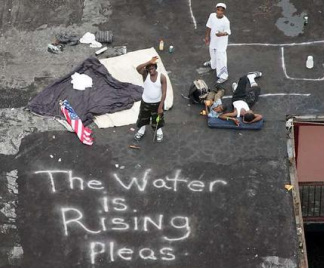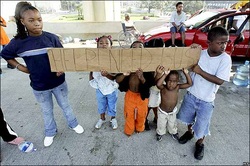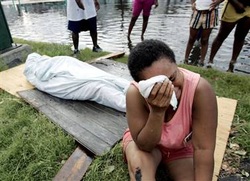Hurricane Katrina in New Orleans, Louisiana
August 29th, 2005

Recent studies have found that the destructive nature and power of hurricanes has been on the rise. This is largely due to the rising global ocean and land temperatures. Katrina was a hurricane that officials had been fearing for a long time. In Louisiana, 500,000 of the residents lived below sea level and completely surrounded by the waters of not only the Mississippi River, but also Lake Pontchartrain and several other bays.
Katrina is Coming.
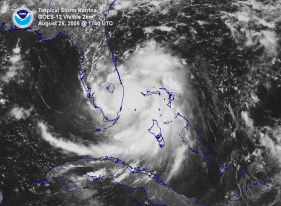
http://www.ncdc.noaa.gov/special-reports/katrina.html
Hurricane Katrina initially developed in the Southeastern Bahamas coast on August 23rd. Ironically enough, the eye of Hurricane Katrina was slated to bypass New Orleans and go east. However in just two days, Katrina was classified as a Category One hurricane. Category One is a hurricane with wind speeds of over 75 miles per hour. An aspect to Katrina that increases its extremely destructive nature was the fact that Katrina spent only seven hours over land. These mere seven hours over land didn’t allow for Katrina’s volatility to diminish whatsoever. Instead, Katrina soon after re-intensified over the warm waters of the Gulf. Hurricane Katrina also created rain bands which produced tornadoes and caused further damages into areas like Georgia. Hurricane Katrina quickly became one of the strongest storms to ever form over the Atlantic Ocean. It had peak winds of 175 miles per hour but fortunately the storm lost some of that speed as it moved closer to the coast.
To add ever more intensity to Katrina, the specific atmosphere and sea-surface conditions were tremendously conducive to Katrina’s strength and path of destruction. The warms SSTs and Upper Level Anticyclone over the Gulf lead Katrina to soon be named ‘major hurricane’ status on August 26th.
To add ever more intensity to Katrina, the specific atmosphere and sea-surface conditions were tremendously conducive to Katrina’s strength and path of destruction. The warms SSTs and Upper Level Anticyclone over the Gulf lead Katrina to soon be named ‘major hurricane’ status on August 26th.
Evacuation.
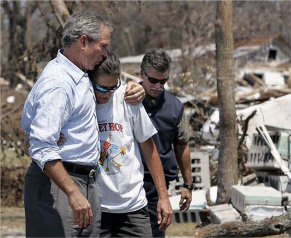
On August 28th, the National Weather Service in New Orleans sent out an announcement predicting immense damage to New Orleans and the area surrounding it. The announcement anticipated damage and destruction to over half of the houses, industrial buildings, and low-rise apartment buildings. They also predicted that there would be a chaotic field of overturned cars, trees, telephone poles, and collapsed buildings. The National Weather Service also sent out their concern for the fact that there would not be an appropriate supply of clean drinking water.
Also on August 28th, the director of the National Hurricane Center made a call to the US President George W. Bush. President Bush was currently on his farm in Crawford, Texas when he heard about the possible graveness of the storm. President Bush soon after came on television and asked people to follow evacuation warnings. Many Gulf Coasters, took evacuation into their own hands. In New Orleans, they began to lock their homes and pack for an evacuation. Many gas stations who were the few who still has gas left, had extremely long lines. Mayor Ray Nagin of New Orleans called for a citywide mandatory evacuation at 9:30 in the morning on August 28th. Unfortunately, not everyone was ready to leave. People felt tied to their homes and couldn’t bear to leave it to possible demolition by the storm.
In Mississippi, cities of Biloxi and Gulfport were underwater by the result of 20-30 ft. storm surges. A.J. Holloway who was the mayor of Biloxi, said that by sunday night most of the cities residents who were in the lowest level of the city had been evacuated. "We don't know what to expect." Holloway said.
Also on August 28th, the director of the National Hurricane Center made a call to the US President George W. Bush. President Bush was currently on his farm in Crawford, Texas when he heard about the possible graveness of the storm. President Bush soon after came on television and asked people to follow evacuation warnings. Many Gulf Coasters, took evacuation into their own hands. In New Orleans, they began to lock their homes and pack for an evacuation. Many gas stations who were the few who still has gas left, had extremely long lines. Mayor Ray Nagin of New Orleans called for a citywide mandatory evacuation at 9:30 in the morning on August 28th. Unfortunately, not everyone was ready to leave. People felt tied to their homes and couldn’t bear to leave it to possible demolition by the storm.
In Mississippi, cities of Biloxi and Gulfport were underwater by the result of 20-30 ft. storm surges. A.J. Holloway who was the mayor of Biloxi, said that by sunday night most of the cities residents who were in the lowest level of the city had been evacuated. "We don't know what to expect." Holloway said.
The Superdome.
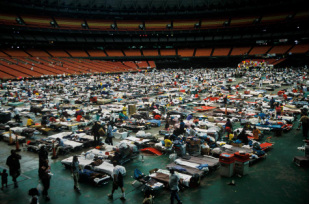
It was mainly the sick and the elderly who weren’t able to leave in time. In the previous year Hurricane Ivan had issued a mandatory evacuation and in the process many senior citizens had gotten ill because of the stalled six to ten hour traffic. So for many of the ones who weren’t able to evacuate in time, the Superdome was their shelter. The Louisiana Superdome had been used as a shelter before as well. In 1998, Hurricanes Georges had high winds of up to 200 mph and the Superdome was used as a place for shelter.
There were six confirmed deaths in the Superdome. There was a suicide, drug overdose, and the other four were thought to have been from natural causes. In the Superdome there were also accounts of violence, a rape, major looting, and overall chaos.
There were six confirmed deaths in the Superdome. There was a suicide, drug overdose, and the other four were thought to have been from natural causes. In the Superdome there were also accounts of violence, a rape, major looting, and overall chaos.
Katrina Arrives.
When Katrina let herself fall on the morning of August 29th over 100,000 people still were in the city and 20,000 more in the Superdome. Many people were trapped in their own homes; they were trapped in their attics, on their rooftops, or anywhere else they had found higher ground. By that evening there were reports of bodies floating in the water, no electricity, and no clean water.
The Failed Levees.
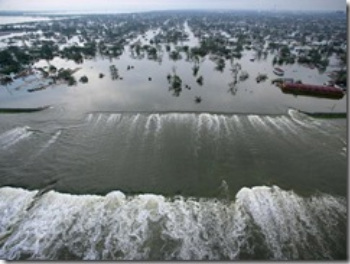
Just two days after Katrina hit, 80% of New Orleans was under water. Some areas were under 15 feet of water. This was largely due to the levee failures from Lake Pontchartrain. The levees were broken by the strong winds, heavy rainfall, and overall storm surge. The over 50 breaks in the levees caused one of the worst engineering disasters in the United States.When the levee disaster was investigated it was found by the US Army of Corps Engineers that the design of the levees was faulty, incomplete, and were a big cause in the damage that New Orleans faced. Amazingly it said that almost two thirds of the flooding in the city would have been avoided if the levees had held.
The Situation at hand.
The final death doll was close to 2,000 people but the number is in reality much higher but the bodies can simply not be retrieved to be fully accounted for. Not only were people killed, but animals as well.
The reason for so much destruction and ruin is largely due to the vulnerability that the Gulf faced. In the last three decades there has been a rapid population growth on US's coast. More than half of the US population live on coastal areas.
The reason for so much destruction and ruin is largely due to the vulnerability that the Gulf faced. In the last three decades there has been a rapid population growth on US's coast. More than half of the US population live on coastal areas.
Aftermath.

The United States and the world as a whole was impacted economically from Katrina. There was a disruption to the oil industry and estimates from the Mineral Management Service suggested that oil production in the Gulf of Mexico was reduced by about 1.4 billion barrels per day. (95% of the daily Gulf production.) Gasoline reached for that time, record high prices as soon as August 30th, a day after the hurricane had hit. Over 1.7 million people lost power due to the storm. It is estimated that the storm in the Gulf cost about 125 billion dollars.
More importantly however, drinking water was unavailable in New Orleans due to broken water mains all over the city. In addition, both of New Orleans’s airports were flooded and the bridges leaving the city on Interstate 10 were destroyed. Essentially there was no leaving the wreckage and horror. Most of the coastal highways along the Gulf were unsafe and basically impassable.
More importantly however, drinking water was unavailable in New Orleans due to broken water mains all over the city. In addition, both of New Orleans’s airports were flooded and the bridges leaving the city on Interstate 10 were destroyed. Essentially there was no leaving the wreckage and horror. Most of the coastal highways along the Gulf were unsafe and basically impassable.
Legislation Passed.
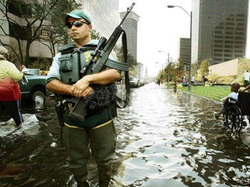
After Hurricane Katrina there was a bill that was proposed by Congress in response to some aspects of Hurricane Katrina. The Disaster Recovery Personal Protection Act of 2006 was brought up by Congress in hopes to allow people to keep their firearms in times of certain national emergencies. This bill passed in the house but has not yet occurred to let the senate vote on the issue. Its provisions have become into the form of the Vitter Amendment. During Hurricane Katrina Chief Polices ordered firearms from citizens to be confiscated.
Click the links below to learn more about Hurricane Galveston and Hurricane Katrina, as well as how they connect and how the government effected each of them.
Galveston
Galveston Blogs
Katrina
Katrina Blogs
The Governments Involvement in the Hurricanes
The Comparing and Contrasting of Hurricane Katrina and Hurricane Galveston
